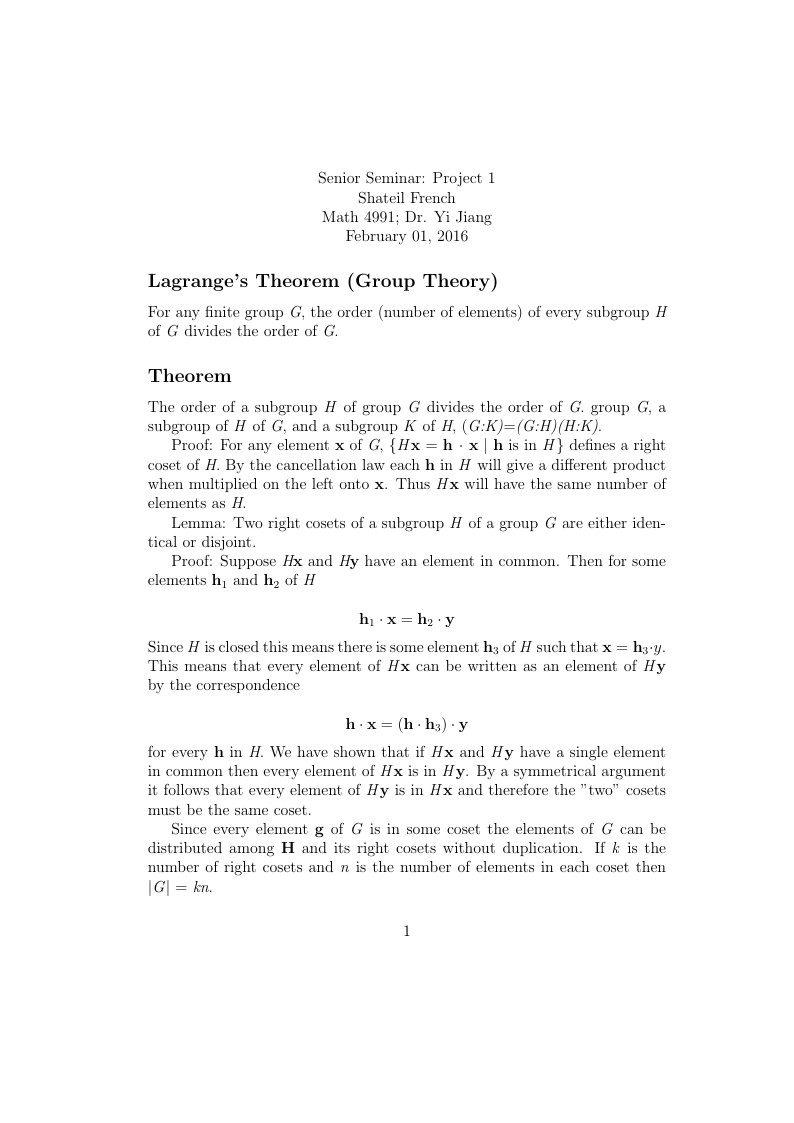
Lagrange's Theorem
Author:
Shateil French
Last Updated:
10 anni fa
License:
Creative Commons CC BY 4.0
Abstract:
Lagrange's Theorem

\begin
Discover why over 20 million people worldwide trust Overleaf with their work.
Lagrange's Theorem

\begin
Discover why over 20 million people worldwide trust Overleaf with their work.
\documentclass[12pt]{article}
\usepackage{amsmath}
\usepackage{amsthm}
\begin{document}
\begin{center}
Senior Seminar: Project 1
\\Shateil French
\\Math 4991; Dr. Yi Jiang
\\February 01, 2016
\end{center}
\subsection*{Lagrange's Theorem (Group Theory)}
For any finite group \emph{G}, the order (number of elements) of every subgroup \emph{H} of \emph{G} divides the order of \emph{G}.
\subsection*{Theorem}
The order of a subgroup \emph{H} of group \emph{G} divides the order of \emph{G}. group \emph{G}, a subgroup of \emph{H}
of \emph{G}, and a subgroup \emph{K} of \emph{H}, (\emph{G:K)}=\emph{(G:H)(H:K)}.
Proof:
For any element \textbf{x} of \emph{G}, \{\emph{H}\textbf{x} = {\textbf{h $\cdot$ x} $\mid$ \textbf{h} is in \emph{H}}\} defines a right coset of \emph{H}. By the cancellation law each \textbf{h} in \emph{H} will give a different product when multiplied on the left onto \textbf{x}. Thus \emph{H}\textbf{x} will have the same number of elements as \emph{H}.
Lemma: Two right cosets of a subgroup \emph{H} of a group \emph{G} are either identical or disjoint.
Proof: Suppose $\emph{H}\textbf{x}$ and $\emph{H}\textbf{y}$ have an element in common. Then for some elements $\textbf{h}_1$
and $\textbf{h}_2$ of $\emph{H}$
$$\textbf{h}_1 \cdot \textbf{x} = \textbf{h}_2 \cdot \textbf{y}$$
Since \emph{H} is closed this means there is some element $\textbf{h}_3$ of \emph{H} such that $\textbf{x} = \textbf{h}_3 \cdot y$. This means that every element of \emph{H}\textbf{x} can be written as an element of \emph{H}\textbf{y} by the correspondence
$$\textbf{h} \cdot \textbf{x} = (\textbf{h} \cdot \textbf{h}_3) \cdot \textbf{y}$$
for every \textbf{h} in \emph{H}. We have shown that if \emph{H}\textbf{x} and \emph{H}\textbf{y} have a single element in common then every element of \emph{H}\textbf{x} is in \emph{H}\textbf{y}. By a symmetrical argument it follows that every element of \emph{H}\textbf{y} is in \emph{H}\textbf{x} and therefore the "two" cosets must be the same coset.
Since every element \textbf{g} of \emph{G} is in some coset the elements of \emph{G} can be distributed among \textbf{H} and its right cosets without duplication. If \emph{k} is the number of right cosets and \emph{n} is the number of elements in each coset then $\mid$\emph{G}$\mid$ = \emph{kn}.
\end{document}